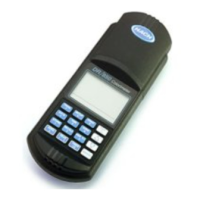104
Method Performance
Precision
In a single laboratory, using a chlorine standard solution of
5.05 mg/L Cl
2
and representative lots of reagent, a single
operator obtained a standard deviation of ± 0.05 mg/L Cl
2
.
Estimated Detection Limit
The estimated detection limit for Method 10069 is 0.1 mg/L Cl
2
.
For more information on the estimated detection limit, see
Section 1 of the DR/800 Procedure Manual.
Interferences
Interfering Substance Interference Levels and Treatments
Acidity Greater than 150 mg/L CaCO
3
. May not develop full color or color may fade
instantly.
1. Neutralize to pH 6–7 with 1 N Sodium Hydroxide.
2. Determine amount to be added on a separate sample aliquot, then add the
same amount to the sample being tested.
3. Correct for volume addition.
Alkalinity Greater than 250 mg/L CaCO
3
. May not develop full color or color may fade
instantly.
1. Neutralize to pH 6–7 with 1 N Sulfuric Acid.
2. Determine amount to be added on a separate sample aliquot, then add the
same amount to the sample being tested.
3. Correct for volume addition.
Bromine, Br
2
Interferes at all levels
Chlorine Dioxide, ClO
2
Interferes at all levels
Chloramines, organic May interfere
Iodine, I
2
Interferes at all levels
Manganese, oxidized (Mn
4+
,
Mn
7+
) or Chromium, oxi-
dized (Cr
6+
)
1. Adjust sample pH to 6–7.
2. Add 2 drops Potassium Iodide (30 g/L) to a 5-mL sample.
3. Mix and wait 1 minute.
4. Add 2 drops of Sodium Arsenite (5 g/L) and mix.
5. Analyze the treated sample as described in the procedure.
6. Subtract the result from this test from the original analysis to obtain the
correct chlorine concentration.
CHLORINE, FREE, Ultra-high Range, continued

